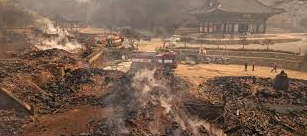Over 27,000 displaced as fires rage across South Korea’s southeastern region
At least 24 people have died in the catastrophic wildfires sweeping through South Korea’s southeastern regions, marking some of the most destructive blazes the country has faced in decades. The fires, fanned by strong winds and dry conditions, have forced more than 27,000 residents to evacuate their homes, with thousands of firefighters and military personnel now involved in efforts to control the infernos.
A tragic helicopter crash on March 26th, while responding to the fires, resulted in the death of the pilot, prompting authorities to suspend all aerial firefighting operations. The crash occurred in Uiseong County, where the wildfires are burning most intensely.
South Korean officials are struggling to contain the fires, which have already ravaged over 17,000 hectares of land. The Uiseong fire, still only 68% contained, has been described as one of “unimaginable” scale and speed, exacerbated by the region’s dry climate and gusting winds. According to government reports, the fires have destroyed entire neighbourhoods, damaged critical infrastructure, and forced the evacuation of prisoners.
The country’s Acting President, Han Duck-soo, described the ongoing devastation as “unprecedented”, noting that the fires were surpassing expectations and causing significant disruption to daily life. Power and communication outages, as well as blocked roads, have compounded the challenges faced by both the authorities and evacuees.
One of the hardest-hit areas, Uiseong County, also saw damage to heritage sites, including Goun Temple, which dates back to 681 AD. Efforts to protect other UNESCO World Heritage sites, such as Hahoe Village and Byeongsan Confucian Academy, continue as the fires spread.
With the wildfires showing no signs of slowing down, the government has raised the crisis alert to its highest level. In response to criticism over inadequate resources, authorities are deploying nearly 5,000 personnel, alongside support from US military helicopters, to assist in firefighting efforts. However, challenges persist, particularly due to technical issues with the fleet of Russian-made helicopters, which have been out of service due to parts shortages linked to sanctions.
Experts are warning that climate change could lead to more frequent and severe wildfires, with South Korea having already experienced a significant increase in fires in 2025 compared to the previous year. The government has promised emergency relief for the displaced, while communities affected by the fires, such as farmers in Andong, are left grappling with the aftermath of this devastating disaster.


